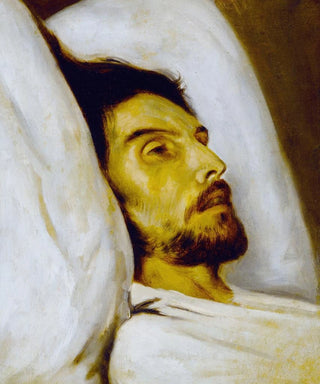Art print | Portrait of a man on his deathbed, formerly known as Armand Carrel - Paul Delaroche


View from behind

Frame (optional)
Introduction captivante
The "Portrait of a man on his deathbed, formerly known as Armand Carrel" by Paul Delaroche is a work that leaves a lasting impression. This painting, which is part of the masterpieces of the 19th century, depicts with poignant intensity the final moment of human life. The scene, imbued with palpable melancholy, invites the viewer to a deep reflection on mortality and memory. Through this art print, one can feel the emotionally charged atmosphere that emanates from this iconic work, where the finesse of details and mastery of colors combine to create an unforgettable visual experience.
Style and uniqueness of the work
Delaroche, renowned for his talent in capturing the essence of human emotions, here transcends the simple portrait. The work stands out for its striking realism, where each element – from the drapes to facial expressions – contributes to a powerful visual narration. The choice of colors, both dark and luminous, accentuates the contrast between life and death, making the scene even more striking. The bed, a symbol of eternal rest, is surrounded by a soft light that seems to caress the face of the deceased, creating an atmosphere that is both serene and tragic. The composition, carefully orchestrated, guides the viewer’s gaze and invites contemplation of the depth of this representation, where beauty mingles with sadness.
The artist and his influence
Paul Delaroche, an emblematic figure of the Romantic movement, managed to mark his era with an innovative approach to historical painting and the depiction of emotions. His work, often inspired by significant events in history, reveals a unique sensitivity that allows him to touch the hearts of viewers. Delaroche was also a pioneer in the use of light and shadow, creating dramatic atmospheres that enhance the emotional impact of his subjects. Through paintings like this one, he paved the way for many artists, influencing future generations in their quest for authenticity and the expression of feelings. His legacy endures, and

Matte finish

View from behind

Frame (optional)
Introduction captivante
The "Portrait of a man on his deathbed, formerly known as Armand Carrel" by Paul Delaroche is a work that leaves a lasting impression. This painting, which is part of the masterpieces of the 19th century, depicts with poignant intensity the final moment of human life. The scene, imbued with palpable melancholy, invites the viewer to a deep reflection on mortality and memory. Through this art print, one can feel the emotionally charged atmosphere that emanates from this iconic work, where the finesse of details and mastery of colors combine to create an unforgettable visual experience.
Style and uniqueness of the work
Delaroche, renowned for his talent in capturing the essence of human emotions, here transcends the simple portrait. The work stands out for its striking realism, where each element – from the drapes to facial expressions – contributes to a powerful visual narration. The choice of colors, both dark and luminous, accentuates the contrast between life and death, making the scene even more striking. The bed, a symbol of eternal rest, is surrounded by a soft light that seems to caress the face of the deceased, creating an atmosphere that is both serene and tragic. The composition, carefully orchestrated, guides the viewer’s gaze and invites contemplation of the depth of this representation, where beauty mingles with sadness.
The artist and his influence
Paul Delaroche, an emblematic figure of the Romantic movement, managed to mark his era with an innovative approach to historical painting and the depiction of emotions. His work, often inspired by significant events in history, reveals a unique sensitivity that allows him to touch the hearts of viewers. Delaroche was also a pioneer in the use of light and shadow, creating dramatic atmospheres that enhance the emotional impact of his subjects. Through paintings like this one, he paved the way for many artists, influencing future generations in their quest for authenticity and the expression of feelings. His legacy endures, and






